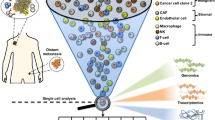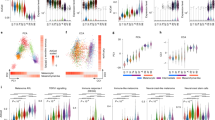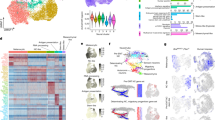Abstract
It is well established that tumours are not homogenous, but comprise cells with differing invasive, proliferative and tumour-initiating potential. A major challenge in cancer research is therefore to develop methods to characterize cell heterogeneity. In melanoma, proliferative and invasive cells are characterized by distinct gene expression profiles and accumulating evidence suggests that cells can alternate between these states through a process called phenotype switching. We have used microfluidic technology to isolate single melanoma cells grown in vitro as monolayers or melanospheres or in vivo as xenografted tumours and analyse the expression profiles of 114 genes that discriminate the proliferative and invasive states by quantitative PCR. Single-cell analysis accurately recapitulates the specific gene expression programmes of melanoma cell lines and defines subpopulations with distinct expression profiles. Cell heterogeneity is augmented when cells are grown as spheres and as xenografted tumours. Correlative analysis identifies gene-regulatory networks and changes in gene expression under different growth conditions. In tumours, subpopulations of cells that express specific invasion and drug resistance markers can be identified amongst which is the pluripotency factor POUF51 (OCT4) whose expression correlates with the tumorigenic potential. We therefore show that single-cell analysis can be used to define and quantify tumour heterogeneity based on detection of cells with specific gene expression profiles.
This is a preview of subscription content, access via your institution
Access options
Subscribe to this journal
Receive 50 print issues and online access
$259.00 per year
only $5.18 per issue
Buy this article
- Purchase on Springer Link
- Instant access to full article PDF
Prices may be subject to local taxes which are calculated during checkout







Similar content being viewed by others
References
Meacham CE, Morrison SJ . Tumour heterogeneity and cancer cell plasticity. Nature 2013; 501: 328–337.
Nazarian R, Shi H, Wang Q, Kong X, Koya RC, Lee H et al. Melanomas acquire resistance to B-RAF(V600E) inhibition by RTK or N-RAS upregulation. Nature 2010; 468: 973–977.
Somasundaram R, Villanueva J, Herlyn M . Intratumoral heterogeneity as a therapy resistance mechanism: role of melanoma subpopulations. Adv Pharmacol 2012; 65: 335–359.
Hoek KS, Goding CR . Cancer stem cells versus phenotype-switching in melanoma. Pigment Cell Melanoma Res 2010; 23: 746–759.
Quintana E, Shackleton M, Foster HR, Fullen DR, Sabel MS, Johnson TM et al. Phenotypic heterogeneity among tumorigenic melanoma cells from patients that is reversible and not hierarchically organized. Cancer Cell 2010; 18: 510–523.
Hoek KS, Eichhoff OM, Schlegel NC, Dobbeling U, Kobert N, Schaerer L et al. In vivo switching of human melanoma cells between proliferative and invasive states. Cancer Res 2008; 68: 650–656.
Widmer DS, Cheng PF, Eichhoff OM, Belloni BC, Zipser MC, Schlegel NC et al. Systematic classification of melanoma cells by phenotype-specific gene expression mapping. Pigment Cell Melanoma Res 2012; 25: 343–353.
Goodall J, Carreira S, Denat L, Kobi D, Davidson I, Nuciforo P et al. Brn-2 represses microphthalmia-associated transcription factor expression and marks a distinct subpopulation of microphthalmia-associated transcription factor-negative melanoma cells. Cancer Res 2008; 68: 7788–7794.
Javelaud D, Alexaki VI, Pierrat MJ, Hoek KS, Dennler S, Van Kempen L et al. GLI2 and M-MITF transcription factors control exclusive gene expression programs and inversely regulate invasion in human melanoma cells. Pigment Cell Melanoma Res 2011; 24: 932–943.
Cheli Y, Guiliano S, Botton T, Rocchi S, Hofman V, Hofman P et al. Mitf is the key molecular switch between mouse or human melanoma initiating cells and their differentiated progeny. Oncogene 2011; 30: 2307–2318.
Ohanna M, Cheli Y, Bonet C, Bonazzi VF, Allegra M, Giuliano S et al. Secretome from senescent melanoma engages the STAT3 pathway to favor reprogramming of naive melanoma towards a tumor-initiating cell phenotype. Oncotarget 2013; 4: 2212–2224.
Chen KG, Valencia JC, Gillet JP, Hearing VJ, Gottesman MM . Involvement of ABC transporters in melanogenesis and the development of multidrug resistance of melanoma. Pigment Cell Melanoma Res 2009; 22: 740–749.
Perego M, Tortoreto M, Tragni G, Mariani L, Deho P, Carbone A et al. Heterogeneous phenotype of human melanoma cells with in vitro and in vivo features of tumor-initiating cells. J Invest Dermatol 2010; 130: 1877–1886.
Thurber AE, Douglas G, Sturm EC, Zabierowski SE, Smit DJ, Ramakrishnan SN et al. Inverse expression states of the BRN2 and MITF transcription factors in melanoma spheres and tumour xenografts regulate the NOTCH pathway. Oncogene 2011; 30: 3036–3048.
Strub T, Giuliano S, Ye T, Bonet C, Keime C, Kobi D et al. Essential role of microphthalmia transcription factor for DNA replication, mitosis and genomic stability in melanoma. Oncogene 2011; 30: 2319–2332.
Kobi D, Steunou AL, Dembele D, Legras S, Larue L, Nieto L et al. Genome-wide analysis of POU3F2/BRN2 promoter occupancy in human melanoma cells reveals Kitl as a novel regulated target gene. Pigment Cell Melanoma Res 2010; 23: 404–418.
Thies A, Moll I, Berger J, Wagener C, Brummer J, Schulze HJ et al. CEACAM1 expression in cutaneous malignant melanoma predicts the development of metastatic disease. J Clin Oncol 2002; 20: 2530–2536.
Caramel J, Papadogeorgakis E, Hill L, Browne GJ, Richard G, Wierinckx A et al. A switch in the expression of embryonic EMT-inducers drives the development of malignant melanoma. Cancer Cell 2013; 24: 466–480.
Chiaverini C, Beuret L, Flori E, Busca R, Abbe P, Bille K et al. Microphthalmia-associated transcription factor regulates RAB27A gene expression and controls melanosome transport. J Biol Chem 2008; 283: 12635–12642.
Dalerba P, Kalisky T, Sahoo D, Rajendran PS, Rothenberg ME, Leyrat AA et al. Single-cell dissection of transcriptional heterogeneity in human colon tumors. Nat Biotechnol 2011; 29: 1120–1127.
Castro FV, Al-Muftah M, Mulryan K, Jiang HR, Drijfhout JW, Ali S et al. Regulation of autologous immunity to the mouse 5T4 oncofoetal antigen: implications for immunotherapy. Cancer Immunol Immunother 2012; 61: 1005–1018.
Perez-Lorenzo R, Gill KZ, Shen CH, Zhao FX, Zheng B, Schulze HJ et al. A tumor suppressor function for the lipid phosphatase INPP4B in melanocytic neoplasms. J Invest Dermatol 2013; 134: 1359–1368.
Liu S, Ren S, Howell P, Fodstad O, Riker AI . Identification of novel epigenetically modified genes in human melanoma via promoter methylation gene profiling. Pigment Cell Melanoma Res 2008; 21: 545–558.
Carreira S, Goodall J, Denat L, Rodriguez M, Nuciforo P, Hoek KS et al. Mitf regulation of Dia1 controls melanoma proliferation and invasiveness. Genes Dev 2006; 20: 3426–3439.
Haass NK, Beaumont KA, Hill DS, Anfosso A, Mrass P, Munoz MA et al. Real-time cell cycle imaging during melanoma growth, invasion, and drug response. Pigment Cell Melanoma Res (e-pub ahead of print 5 June 2014; doi:10.1111/pcmr.12274).
McDavid A, Finak G, Chattopadyay PK, Dominguez M, Lamoreaux L, Ma SS et al. Data exploration, quality control and testing in single-cell qPCR-based gene expression experiments. Bioinformatics 2013; 29: 461–467.
Herquel B, Ouararhni K, Martianov I, Le Gras S, Ye T, Keime C et al. Trim24-repressed VL30 retrotransposons regulate gene expression by producing noncoding RNA. Nat Struct Mol Biol 2013; 20: 339–346.
Trapnell C, Pachter L, Salzberg SL . TopHat: discovering splice junctions with RNA-Seq. Bioinformatics 2009; 25: 1105–1111.
Langmead B, Trapnell C, Pop M, Salzberg SL . Ultrafast and memory-efficient alignment of short DNA sequences to the human genome. Genome Biol 2009; 10: R25.
Anders S, Huber W . Differential expression analysis for sequence count data. Genome Biol 2010; 11: R106.
Denecker G, Vandamme N, Akay O, Koludrovic D, Taminau J, Lemeire K et al. Identification of a ZEB2-MITF-ZEB1 transcriptional network that controls melanogenesis and melanoma progression. Cell Death Differ 2014; 21: 1250–1261.
Acknowledgements
We thank D Dembélé for help with data analysis, all the staff of the IGBMC common facilities, as well as F Kardouz and the staff of the Strasbourg Hospital Dermatology Clinic, This work was supported by institutional grants from the Centre National de la Recherche Scientifique, the Institut National de Sante et de la Recherche Médicale, the Université de Strasbourg, the Association pour la Recherche contre le Cancer, the Ligue Nationale contre le Cancer, the Institut National du Cancer PAIR-melanoma grant, the ANR-10-LABX-0030-INRT French state fund through the Agence Nationale de la Recherche under the frame programme Investissements d’Avenir labelled ANR-10-IDEX-0002-02. The IGBMC high throughput sequencing facility is a member of the ‘France Génomique’ consortium (ANR10-INBS-09-08). ID is an ‘équipe labellisée’ of the Ligue Nationale contre le Cancer. ME was supported by a fellowship from the Ligue Nationale contre le Cancer.
Author Contributions
ID, ME and CK designed the experiments. ME, CK, CT-C developed methodologies and performed the experiments. CK and ME performed the bioinformatics and computational analyses. DL provided the human melanoma samples and analysed the images. ID, ME and CK wrote the paper.
Author information
Authors and Affiliations
Corresponding author
Ethics declarations
Competing interests
The authors declare no conflict of interest.
Additional information
Supplementary Information accompanies this paper on the Oncogene website
Supplementary information
Rights and permissions
About this article
Cite this article
Ennen, M., Keime, C., Kobi, D. et al. Single-cell gene expression signatures reveal melanoma cell heterogeneity. Oncogene 34, 3251–3263 (2015). https://doi.org/10.1038/onc.2014.262
Received:
Revised:
Accepted:
Published:
Issue Date:
DOI: https://doi.org/10.1038/onc.2014.262
This article is cited by
-
Intratumor heterogeneity index of breast carcinomas based on DNA methylation profiles
BMC Cancer (2019)
-
SOX9 is a dose-dependent metastatic fate determinant in melanoma
Journal of Experimental & Clinical Cancer Research (2019)
-
High-resolution label-free 3D mapping of extracellular pH of single living cells
Nature Communications (2019)
-
Dying cells expose a nuclear antigen cross-reacting with anti-PD-1 monoclonal antibodies
Scientific Reports (2018)
-
The master role of microphthalmia-associated transcription factor in melanocyte and melanoma biology
Laboratory Investigation (2017)



